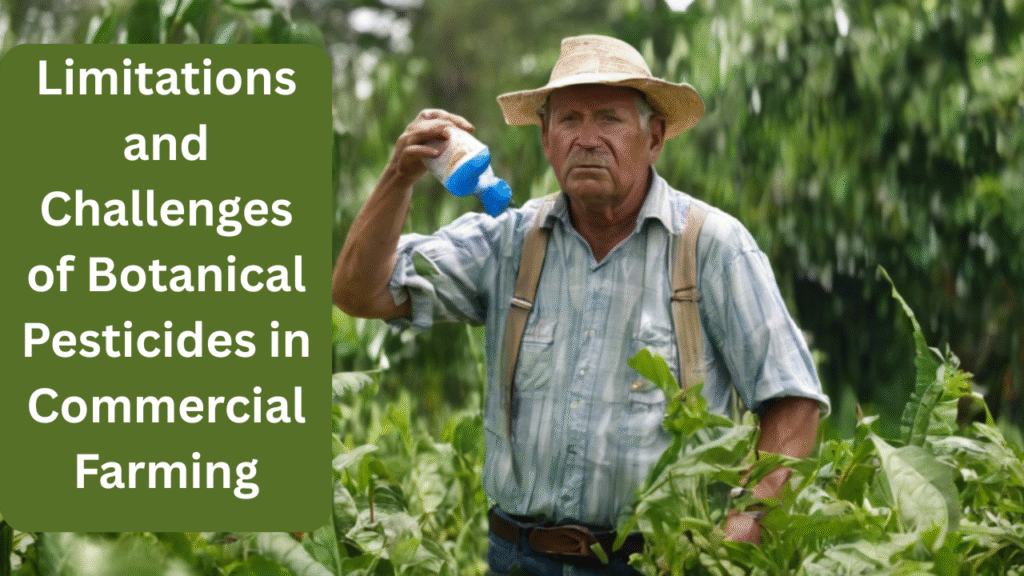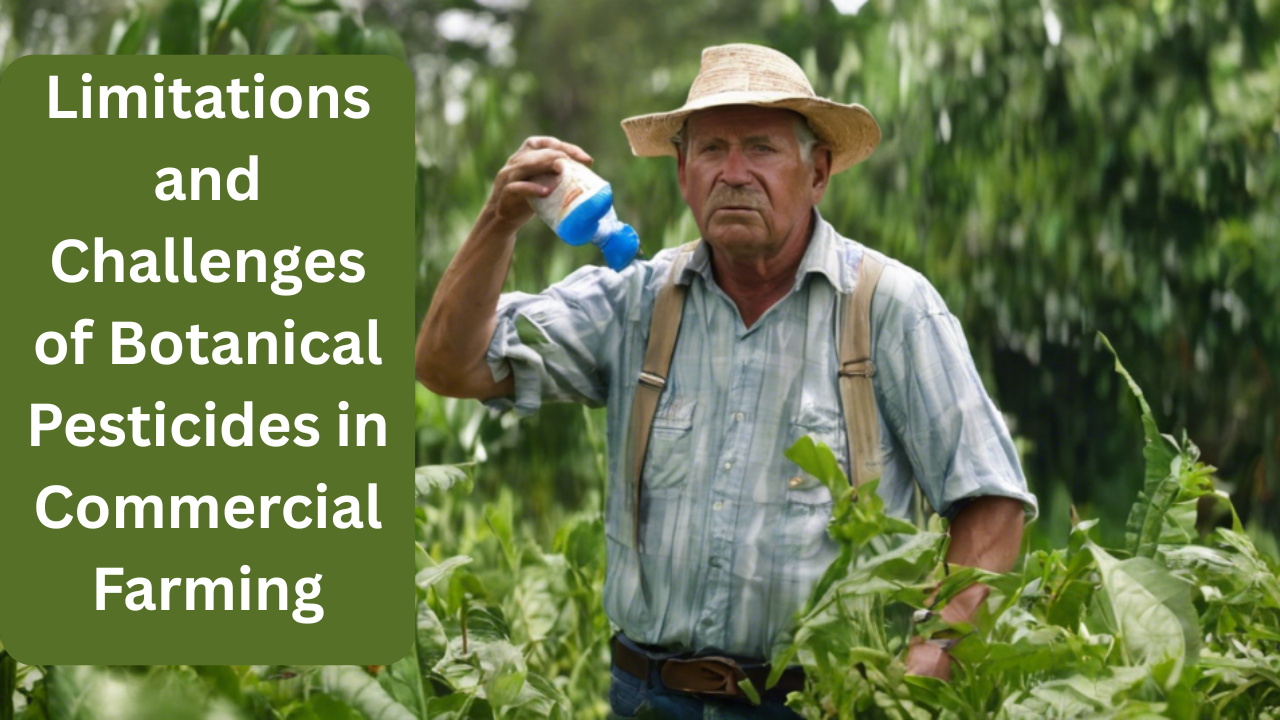
While botanical pesticides are hailed as sustainable, non-toxic, and environmentally friendly, their application in large-scale commercial farming faces a range of technical, logistical, and economic challenges. Despite growing interest from organic growers and eco-conscious consumers, the mainstream adoption of plant-based pest control is still limited by several key limitations.
This article explores the real-world challenges facing botanical pesticide use in commercial agriculture, supported by comparative insights, data, and practical implications for future scaling.
Overview Table: Common Limitations in Botanical Pesticide Use
| Challenge Area | Limitation Example | Impact on Farming | Requires Solution In |
|---|---|---|---|
| Stability | Rapid degradation under sunlight | Short residual activity | Formulation technology |
| Efficacy | Variable potency of plant extracts | Inconsistent pest control | Standardization & testing |
| Economics | High cost of processing or frequent use | Unfeasible for large-scale operations | Cost-efficient production |
| Regulatory | Inadequate or slow approval processes | Delays in market availability | Policy reform & fast-tracking |
| Supply Chain | Seasonal availability of plant sources | Limited year-round production | Cultivation contracts & storage |
| Scalability | Difficult to apply on monoculture mega-farms | Operational inefficiency | Mechanized delivery systems |
1. Short Residual Activity and Poor Stability
One of the biggest technical hurdles with botanical pesticides is rapid degradation after application.
- Light, heat, and rain can break down active compounds within hours
- Essential oils and plant alkaloids often evaporate quickly
- Frequent reapplication is required—sometimes every 2-3 days
This makes them less suitable for large farms that require long-lasting protection across hundreds of hectares. For example, neem-based insecticides may need reapplication after rain, unlike systemic synthetic alternatives.
2. Inconsistent Efficacy and Lack of Standardization
Botanical products often vary in quality due to:
- Differences in plant chemotypes and soil/climate conditions
- Extraction method inconsistencies (water vs oil vs alcohol)
- Improper storage, leading to loss of bioactivity
This means a garlic-chili spray made by one farmer may work, while another’s fails due to lower active ingredient concentration. For commercial use, such variability is a liability.
Result:
- Difficulty in dose optimization
- Unreliable outcomes across different geographies or seasons
- Lower farmer confidence
3. Higher Labor and Application Costs
While natural ingredients may seem cheap, botanical pest control becomes expensive in terms of:
- Labor required for frequent application
- High dosage volumes needed compared to potent synthetics
- Specialized sprayers or emulsifiers for oily extracts
Large farms relying on mechanized operations find these requirements hard to integrate, reducing cost-effectiveness.
4. Regulatory and Approval Barriers
In many countries, pesticide regulation frameworks are heavily geared toward synthetic agrochemicals. Botanical products face:
- Lengthy and expensive registration processes
- Lack of separate guidelines for traditional or indigenous formulations
- Unclear legal definitions for biopesticides vs plant tonics
This hinders private sector innovation and discourages local businesses from commercializing effective plant-based products.
5. Seasonal and Localized Supply Chains
Many botanicals, such as neem, pyrethrum, or citronella, are seasonally harvested and grown in specific regions.
- This restricts raw material availability
- Increases storage and preservation challenges
- Creates supply instability for year-round use
For example, essential oils from lemongrass may be available only during certain months, affecting continuous production.
Comparative Table: Botanical vs Synthetic Pesticide Limitations
| Factor | Botanical Pesticides | Synthetic Pesticides |
|---|---|---|
| Residual Duration | Short (1–5 days) | Long (7–30+ days) |
| Environmental Impact | Low | Moderate to High |
| Consistency | Variable due to raw material diversity | High due to synthetic standardization |
| Resistance Risk | Low (multi-compound mode of action) | High (target-specific chemicals) |
| Regulatory Approval | Slow, fragmented | Established and streamlined |
| Cost at Scale | High due to volume and frequency needed | Lower when mass-produced |
6. Lack of Farmer Awareness and Technical Training
Botanical pesticides often require more knowledge for:
- Proper formulation and mixing
- Correct timing of application
- Understanding plant-pest interaction cycles
In many regions, extension services focus on synthetic chemicals, leaving a knowledge gap in botanical use. This gap leads to misuse, underperformance, or complete abandonment by commercial users.
7. Limited Investment and Commercial Interest
Private sector players hesitate to invest in botanical products due to:
- Lower profit margins than synthetic products
- Intellectual property challenges with traditional knowledge
- Less demand from large-scale monoculture farms
Until consumer and policy pressure increases demand for “green” solutions, botanical pesticides may remain niche.
Moving Forward: What Can Bridge the Gap?
| Area of Improvement | Strategic Action Needed |
|---|---|
| Product Standardization | Scientific validation of active ingredients and doses |
| Advanced Formulations | Nano-encapsulation, UV-stabilizers, and slow-release systems |
| Farmer Education | Extension programs focused on biopesticide use |
| Regulatory Clarity | Dedicated fast-track channels for botanicals |
| Private Sector Incentives | R&D subsidies and public-private partnerships |
Conclusion
Botanical pesticides hold great promise for sustainable farming, but their path to mainstream commercial adoption is obstructed by real and solvable challenges. From inconsistent efficacy to regulatory slowdowns, these limitations must be addressed through science, policy, and industry cooperation. Until then, botanical pesticides will remain powerful tools best suited for integrated pest management and small to mid-scale farms, rather than standalone solutions for industrial agriculture.
FAQs
Q1: Why do botanical pesticides need frequent reapplication?
Because they degrade quickly in sunlight and rain, reducing their effectiveness over time.
Q2: Are all botanical pesticides approved for commercial farming?
No, many still await regulatory approval due to unclear or outdated biopesticide laws.
Q3: Can botanical pesticides replace synthetics completely?
Not yet—most effective use is in integrated pest management, not as sole agents.

